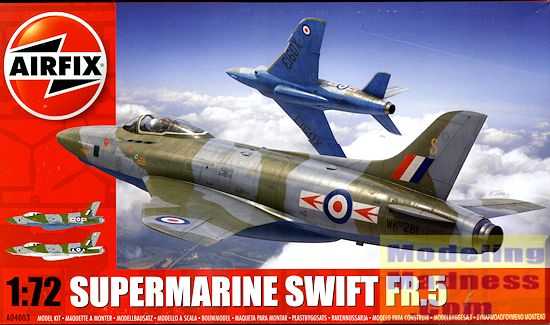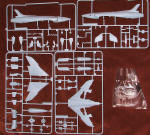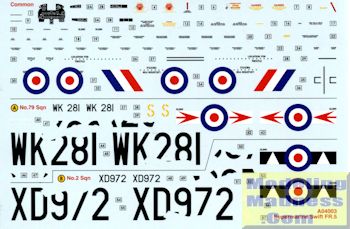
| KIT #: | A04003 |
| PRICE: | $18.99 SRP |
| DECALS: | Two options |
| REVIEWER: | Scott Van Aken |
| NOTES: |
New tool kit |

| HISTORY |
The Swift had been ordered into "super-priority" production, a policy created by Sir Winston Churchill who had become Prime Minister in 1951 at a time of particular tension between NATO and the Warsaw Pact during the Cold War; the Korean War had begun in 1950. The first production variant was a fighter designated the Swift F Mk 1, of which 18 were eventually built. The first flight took place on 25 August 1952. Peter Thorne senior service test pilot for the new swept-wing Swift, it had a troublesome engine and some unusual handling qualities — and many, including Thorne, did not think it suitable. The F.1 entered service with No. 56 Squadron RAF in February 1954, becoming the RAF's first swept-wing aircraft. It was powered by a 7,500 lbf (33.4 kN)-thrust Avon 109 engine and carried an armament of two 30 mm ADEN cannon.
The second variant was the F Mk 2, of which 16 were built. This was an F 1 with two extra ADENs. However, the addition of these cannon caused problems as the structural modifications required to house the increased ammunition load led to dangerous handling problems with the aircraft. Numerous further modifications were then required to resolve this issue.
The third Swift variant was the F Mk 3, with 25 being built and powered by an Avon 114 engine with reheat. It was never taken into operational service with the Royal Air Force and was used as an instructional airframe. The next variant was the F Mk.4, which included a variable incidence tailplane intended to correct the handling problems that the Swift suffered from. It did indeed fix the problem; however, it was found that reheat could not actually be ignited at high altitude which added to the problems that the Swift variants suffered from.
The next in the line, the FR Mk 5, had a longer nose to accommodate a number of cameras to suit the reconnaissance role and had other modifications to its structure. The FR 5 also reverted to the F 1's 2 ADEN armament. It first flew in 1955 and entered service the following year. It performed its reconnaissance mainly at low level, making the reheat problem at high altitude irrelevant.
| THE KIT |
 Considering what a general failure this aircraft turned out to be, it is
surprising that it has been kitted at all. However, Hawk was one of the first to
offer the aircraft in plastic way back when. While Testors apparently re-issued
this kit as it has many old Hawk molds, it took nearly fifty years before we would see another
mainstream kit. To their credit, Airfix has produced probably the best of the
batch, the FR.5 low level recon fighter.
Considering what a general failure this aircraft turned out to be, it is
surprising that it has been kitted at all. However, Hawk was one of the first to
offer the aircraft in plastic way back when. While Testors apparently re-issued
this kit as it has many old Hawk molds, it took nearly fifty years before we would see another
mainstream kit. To their credit, Airfix has produced probably the best of the
batch, the FR.5 low level recon fighter.
First thing I noticed when opening the box is that there was a little bit of flash on a few parts, mostly the camera openings on the fuselage. There are four regular and one clear sprue with the kit. There were ejector pin marks on the inside of the main gear doors, exhaust, and the intake trunking as well as the interior of the fuselage. The rudder, ailerons and flaps are separate. The flaps are designed to be modeled in the lowered position. Many period photos show them raised so you can do it either way and not be 'wrong'. I found it interesting that the ailerons can be installed once the wings are completed.
The kit has a nicely appointed interior with optional seats; one having belt detail and the other left blank. There are well done sidewalls and a very scale control stick which will have to be quite carefully removed to keep from it breaking in the process.
In line with other modern Airfix kits, one can model
this one with the gear up to place on the optional display stand. In addition to
clear camera windows, solid plugs are provided, which I assume are supposed to
represent covers. The kit has a complete intake with compressor face. I found it
interesting that the instructions state the intakes should be painted black.
There is a full afterburner along with the final compressor stage for the rear.
Apparently 3 grams weight is all that is needed and there is room above the nose
gear well for this. The only real option is whether or not to install the belly
fuel tank. This
 was usually
carried, though it does little for the looks of the airplane.
was usually
carried, though it does little for the looks of the airplane.
The instructions have some added color and the usual irritating tendency to use only Humbrol numbers for any color that is not part of the external color scheme. Markings are given for two plane. The box art plane from 79 Squadron is in dark green/dark sea grey over PRU blue. The other from 2 Squadron has aluminum undersides. The only other unit to fly this plane operationally was 4 Squadron so if you want to do one of those, you'll have to rely on outside sources for any unique markings. The decals are nicely printed and a full data placement guide is provided in the instructions.
| CONCLUSIONS |
Despite this being the next to last somewhat successful Supermarine aircraft (the Scimitar was the last), it has not had much plastic cut on it until now. I am sure that many are quite pleased to see this one and it does help to fill the ever-decreasing gaps for the RAF fan.
| REFERENCES |
http://en.wikipedia.org/wiki/Supermarine_Swift
December 2014
Thanks to me for picking this one up.
If you would like your product reviewed fairly and fairly quickly, please contact the editor or see other details in the Note to Contributors.